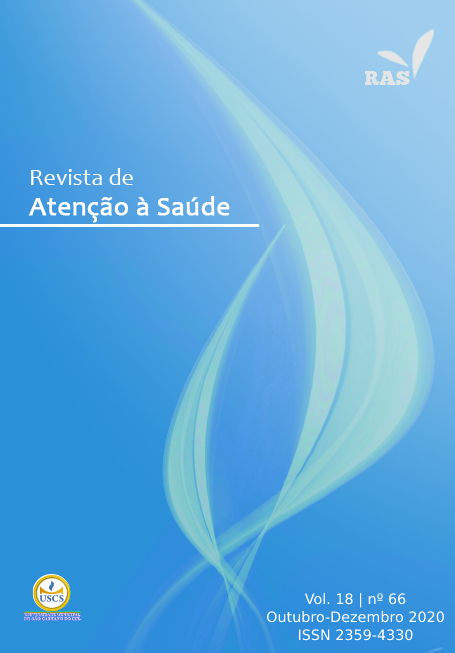GENDER INEQUALITIES AND SMOKING IN BRAZILIAN PEOPLE 50 YEARS OR MORE
Gender Inequality in Brazilian Smokers
Keywords:
Gender and Health, Smoking, AgingAbstract
BACKGROUND: Smoking is a risk factor responsible for the large number of deaths in South American countries, being an important risk factor for the occurrence of chronic non-communicable diseases, especially circulatory diseases. In addition, the unfair and avoidable inequalities derived from social position, roles and expectations between men and women in society are evident and can influence smoking. OBJECTIVES: Was to estimate the differences between socioeconomic and demographic factors associated with smoking independently between Brazilian men and women over the age of 50 years. METHODS: This is a cross-sectional study, composed of 9,412 individuals. Demographic and socioeconomic factors were collected through individual and household questionnaires in 2015. Prevalence ratios were obtained using multivariate Poisson regression. RESULTS: Women living in rural areas had a 35% lower prevalence of smoking than those living in urban areas. It was also observed that women with a higher education level than 12 years of university study had a 28% lower prevalence when compared to those who studied up to 3 years. In both cases, men were not statistically associated CONCLUSIONS: It is suggested that public health policies should consider gender equity as a criterion for implementing policies aimed at reducing smoking.
Downloads
References
Krieger N. Theories for social epidemiology in the 21st century: an ecosocial perspective. International Journal of Epidemiology. agosto de 2001;30(4):668–77.
US National Institute of Aging. World Health Organization. Global health and aging. Bethesda: National Institutes of Health; 2011. (NIH Publication, 11-7737).
World Health Organization (WHO). Global status report on noncommunicable diseases 2010 [Internet]. Geneva: WHO; 2011.
Lim SS, Vos T, Flaxman AD, Danaei G, Shibuya K, Adair-Rohani H, et al. A comparative risk assessment of burden of disease and injury attributable to 67 risk factors and risk factor clusters in 21 regions, 1990–2010: a systematic analysis for the Global Burden of Disease Study 2010. The Lancet. 2012;380(9859):2224–60.
Corsi DJ, Boyle MH, Lear SA, Chow CK, Teo KK, Subramanian SV. Trends in smoking in Canada from 1950 to 2011: progression of the tobacco epidemic according to socioeconomic status and geography. Cancer Causes Control. 2014;25(1):45–57.
Abdulrahim S, Jawad M. Socioeconomic differences in smoking in Jordan, Lebanon, Syria, and Palestine: A cross-sectional analysis of national surveys. El Bcheraoui C, organizador. PLoS ONE. 2018;13(1):e0189829.
Kenney BA, Holahan CJ, Holahan CK, Brennan PL, Schutte KK, Moos RH. Depressive symptoms, drinking problems, and smoking cessation in older smokers. Addictive Behaviors. 2009;34(6–7):548–53.
Cherepanov D, Palta M, Fryback DG, Robert SA. Gender differences in health-related quality-of-life are partly explained by sociodemographic and socioeconomic variation between adult men and women in the US: evidence from four US nationally representative data sets. Qual Life Res. 2010;19(8):1115–24.
Pinto M, Bardach A, Palacios A, Biz A, Alcaraz A, Rodriguez B, et al. Carga do tabagismo no Brasil e benefício potencial do aumento de impostos sobre os cigarros para a economia e para a redução de mortes e adoecimento. Cad Saúde Pública. 2019;35(8):e00129118.
Reitsma MB, Fullman N, Ng M, Salama JS, Abajobir A, Abate KH, et al. Smoking prevalence and attributable disease burden in 195 countries and territories, 1990–2015: a systematic analysis from the Global Burden of Disease Study 2015. The Lancet. 2017;389(10082):1885–906.
Lima-Costa MF, de Andrade FB, Souza PRB de, Neri AL, Duarte YA de O, Castro-Costa E, et al. The Brazilian Longitudinal Study of Aging (ELSI-Brazil): Objectives and Design. American Journal of Epidemiology. 2018;187(7):1345–53.
Malta DC, Iser BPM. Tendencias temporales en el consumo de tabaco en las capitales brasileñas, según datos de VIGITEL, 2006 a 201. Cad Saúde Pública. 2013;11.
Andrade FB de, Antunes JLF, Souza Junior PRB de, Lima-Costa MF, Oliveira CD. Life course socioeconomic inequalities and oral health status in later life. Rev saúde pública. 2019;52(Suppl 2):7s.
IBGE. Censo Demográfico 2016 – Características Gerais da População. Resultados da Amostra. IBGE, 2016.
Fry K, Firestone R, Chakraborty N. Measuring equity with nationally representative wealth, quintiles. Washington (DC): PSI; 2014. Wealth-Quintile-Guide.
Amos A. From social taboo to “torch of freedom”: the marketing of cigarettes to women. Tobacco Control. 2000;9(1):3–8.
Gil-Lacruz AI, Gil-Lacruz M, Leeder S. Women and smoking — Prices and health warning messages: Evidence from Spain. Addictive Behaviors. 2015;45:294–300.
Bilal U, Beltrán P, Fernández E, Navas-Acien A, Bolumar F, Franco M. Gender equality and smoking: a theory-driven approach to smoking gender differences in Spain. Tob Control. 2016;25(3):295–300.
World Health Organization (WHO). WHO report on the global tobacco epidemic, 2013. Enforcing bans on tobacco advertising, promotion and sponsorship. Geneva: WHO 2013. Disponível em: Disponível em: http://apps.who.int/iris/bitstream/10665/85380/1/9789241505871_eng.pdf?ua=1 . (Acessado em 31 de maio de 2020).
Vargas MA, Oliveira BF de. Estratégias de diversificação em áreas de cultivo de tabaco no Vale do Rio Pardo: uma análise comparativa. Rev Econ Sociol Rural. 2012;50(1):175–92.
Reis MM dos, Oliveira APN de, Turci SRB, Dantas RM, Silva V dos SP da, Gross C, et al. Conhecimentos, atitudes e práticas de agricultoras sobre o processo de produção de tabaco em um município da Região Sul do Brasil. Cad Saúde Pública. 2017;33(suppl 3).
Saleeon T, Siriwong W, Maldonado-Pérez H, Robson M. Green Tobacco Sickness among Thai Traditional Tobacco Farmers, Thailand. Int J Occup Environ Med. 2015;6(3):169–76.
Park S-J, Lim H-S, Lee K, Yoo S-J. Green Tobacco Sickness Among Tobacco Harvesters in a Korean Village. Safety and Health at Work. 2018;9(1):71–4.
Meucci RD, Fassa AG, Faria NMX, Fiori NS. Chronic low back pain among tobacco farmers in southern Brazil. International Journal of Occupational and Environmental Health. 2015;21(1):66–73.
Monteiro C. Population-based evidence of a strong decline in the prevalence of smokers in Brazil (1989-2003). Bull World Health Organ. 2007;85(7):527–34.
Malta DC, Oliveira TP, Vieira ML, Almeida L, Szwarcwald CL. Uso e exposição à fumaça do tabaco no Brasil: resultados da Pesquisa Nacional de Saúde 2013. Epidemiol Serv Saúde. 2015;24(2):239–48.
Szklo AS, Levy D, Souza MC de, Szklo M, Figueiredo VC, Perez C, et al. Changes in cigarette consumption patterns among Brazilian smokers between 1989 and 2008. Cad Saúde Pública. 2012;28(11):2211–5.
Peixoto SV, Firmo JOA, Lima-Costa MF. Factors associated to smoking habit among older adults (The Bambuí Health and Aging Study). Rev Saúde Pública. 2005;39(5):746–53.
Ji M, Hofstetter CR, Hovell M, Irvin V, Song YJ, Lee J, et al. Smoking cessation patterns and predictors among adult Californians of Korean descent. Nicotine & Tobacco Research. 2005;7(1):59–69.
Peixoto SV, Firmo JOA, Lima-Costa MF. Condições de saúde e tabagismo entre idosos residentes em duas comunidades brasileiras (Projetos Bambuí e Belo Horizonte). Cad Saúde Pública. 2006;22(9):1925–34.
Sex differences in morbidity and mortality. 2005;42(2):26.
Malmusi D, Artazcoz L, Benach J, Borrell C. Perception or real illness? How chronic conditions contribute to gender inequalities in self-rated health. The European Journal of Public Health. 2012;22(6):781–6.
Krieger N. Discrimination and Health Inequities. Int J Health Serv. 2014;44(4):643–710.
Farrelly MC, Bray JW, Pechacek T, Woollery T. Response by Adults to Increases in Cigarette Prices by Sociodemographic Characteristics. Southern Economic Journal. 2001;68(1):156.
Reitsma MB, Fullman N, Ng M, Salama JS, Abajobir A, Abate KH, et al. Smoking prevalence and attributable disease burden in 195 countries and territories, 1990–2015: a systematic analysis from the Global Burden of Disease Study 2015. The Lancet. 2017;389(10082):1885–906.
Downloads
Published
Issue
Section
License
Copyright (c) 2021 Orlando Luiz do Amaral Júnior, Maria Laura Braccini Fagundes , Gabriele Rissotto Menegazzo , Jessye Melgarejo do Amaral Giordani

This work is licensed under a Creative Commons Attribution-NonCommercial-ShareAlike 4.0 International License.
Policy Proposal for Journals offering Free Delayed Access
Authors who publish in this magazine agree to the following terms:
- Authors maintain the copyright and grant the journal the right to the first publication, with the work simultaneously licensed under a Creative Commons Attribution License after publication, allowing the sharing of the work with recognition of the authorship of the work and initial publication in this journal.
- Authors are authorized to assume additional contracts separately, for non-exclusive distribution of the version of the work published in this magazine (eg, publishing in institutional repository or as a book chapter), with the acknowledgment of the authorship and initial publication in this journal.
- Authors are allowed and encouraged to publish and distribute their work online (eg in institutional repositories or on their personal page) at any point before or during the editorial process, as this can generate productive changes, as well as increase impact and citation of the published work (See The Effect of Open Access).









